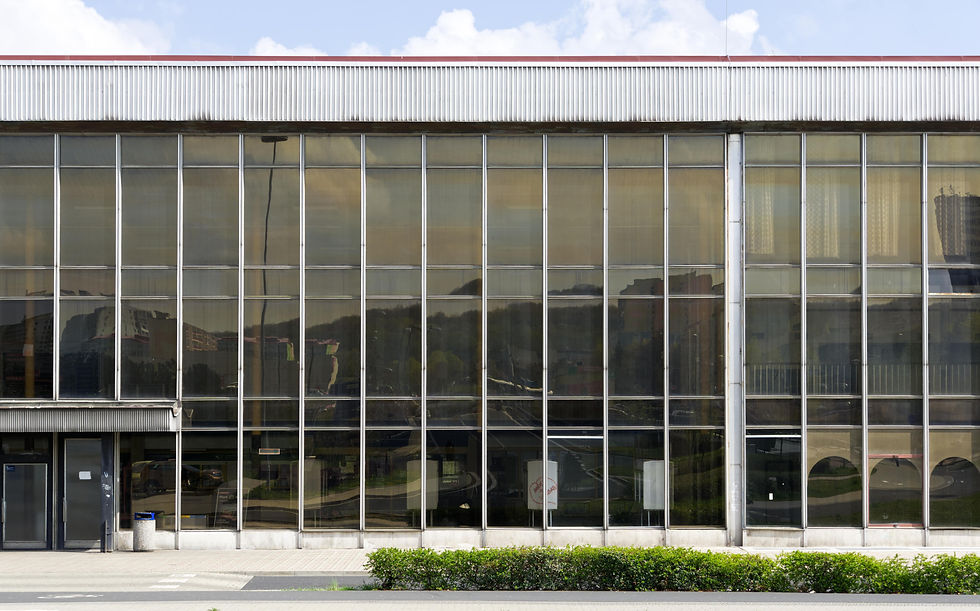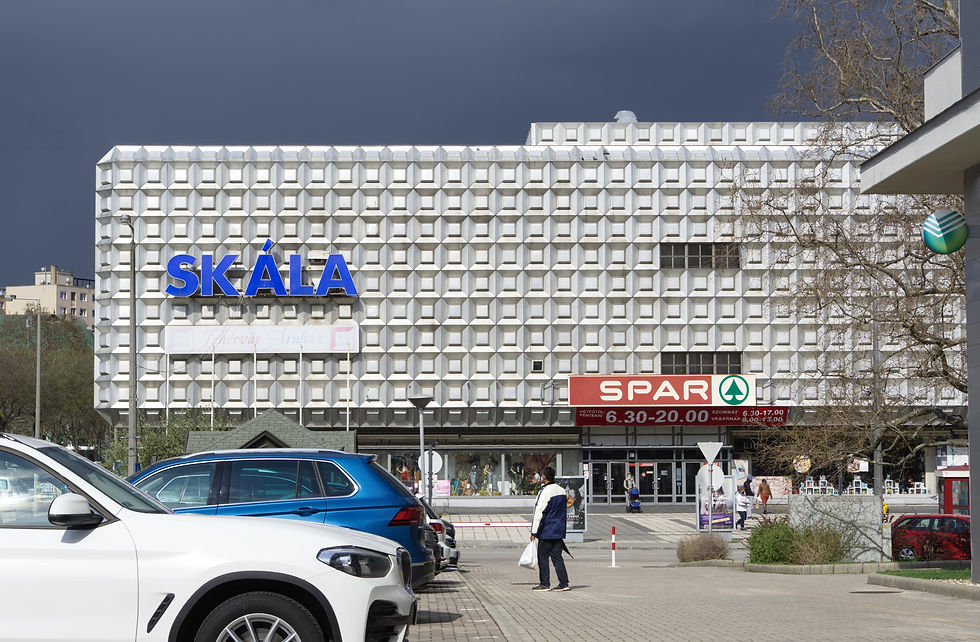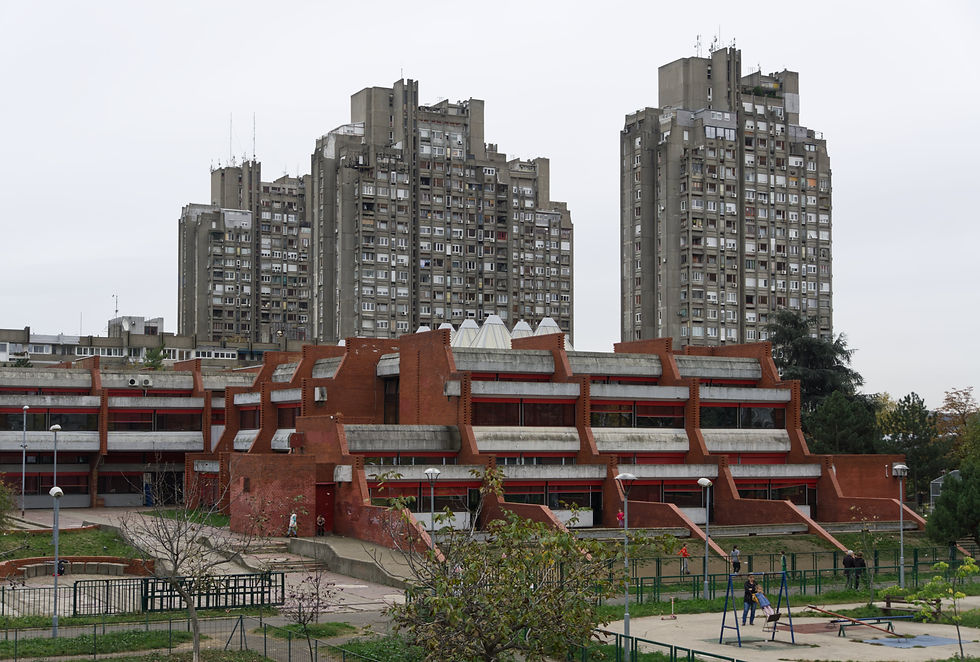Debunking the Myths of "Socialist Modernism"
Part I: Materials
Few architectural styles have been so uncritically reviled as “Socialist Modernism”, a catch-all term that refers to the numerous offshoots of modern architectural trends that were adopted in the former Soviet Union and its sphere of influence. Post-war Modernism in this region of the world only began to thrive after the state-sponsored repudiation of Socialist Realism in 1954. But if the latter’s style is nowadays relatively well appreciated (albeit controversial at times), the former is mainly seen as a colossal architectural failure without any redeeming quality; a trend that produced countless eye sores that should be erased from the cityscape, preferably without leaving the slightest trace of their existence. “Social Modernism” is often perceived as a violent onslaught by an external force (the Communists) on “authentic local architecture”, an underlying assumption of illegitimacy that serves to bar “Socialist Modernism” from qualifying as a genuine architectural movement. These misconceptions can propagate at will and turn into accepted truth simply because until recently, there have been few efforts to undertake a serious study of Eastern Modernist trends and propose valid counterarguments. The anti “SocMod” can dictate their narrative with ease since no counter-narrative backed by substantial facts has found acceptance within the general public as of yet. This is of course a broad generalization that glosses over some regional particularities. Nonetheless, the result is undeniable: Socialist Modernism is still widely misunderstood by its friends and foes alike.
The purpose of this series of articles is to shed new light on the style by debunking a series of enduring myths. Of course, this is not an academic paper, so for the sake of readability I will not delve into the level of detail that such a vast topic would deserve. In this first article, I chose to tackle the purely visual aspect of Eastern Modernism by uncovering the origins of three particularly conspicuous architectural features: glass curtains, metallic façades, and poured concrete.
The idea is to deconstruct piece by piece the most enduring myth of Socialist Modernism: that of a singularly “Communist” style disconnected from Western influences.
Glass curtains

Most Railway Station. In Czechoslovakia, glass curtains were known as "Boletický panel".
Particularly popular from the 1960s onward, glass curtains were the solution of choice for cheap, practical yet aesthetically pleasing facades. If nowadays they tend to be associated chiefly with administrative buildings, glass curtains were by nature very polyvalent and used extensively on virtually every kind of structure ranging from railway stations to stadiums. Glass curtains can be articulated around a variety of patterns, but the style initially adopted by Eastern modernists architects and the most recognizable of all is the familiar repetition of ribbon windows stacked over rows of glazed (and often colored) panels. The uniformized nature of glass curtains was well-suited to the rigidity of a planned economy, which in turn led to their ubiquitous presence in “Socialist cities”. This, coupled with their radical modernity contributed to tarnishing their image and associating them with “Communism”.
The origins of glass curtains as cladding elements in architecture can be traced back to the 19th century in the works of early British and German proto-modernists. Nonetheless, the specific type of glass curtain that defined post-war modernism and “SocMod” was pioneered by the legendary American architectural firm Skidmore Owings and Merill in their seminal masterpiece: the Lever House. Designed in the late 1940s and inaugurated in 1952, the New York skyscraper was the first building to be entirely wrapped up in an elegant glass curtain¹ at a time when Neo-Classical colonnades and kitsch palaces were sprouting all across the Eastern Bloc. Modernist architects of the Communist sphere would eventually catch up with the trend, but not before glass curtains became a staple of modernism in the West.
More than half a century later, the popularity of glass curtains in contemporary architecture is showing little signs of abatement.
Metal façades

Fehérvár Áruház
From the late 1960s to the 1970s, a curious architectural trend penetrated into the Eastern Bloc. Freed from the rigid dogmas of Socialist Realism, architects began to design radically modern metal-cladded façades often adorned with repetitive geometric patterns covering the whole structure, turning buildings into shiny exhibitions of abstract geometry. The fashion was especially popular among department store designers across the Eastern Bloc.
Unlike glass curtains, the geometric-patterned aluminum façades fell out of fashion after the 1970s and never made a true comeback. Consequently, it only thrived during the Socialist time and came to represent the coldness and greyness so commonly associated with the era.
Ironically, the trend’s origins could not have been less socialistic. Metal façades predate World War II, but it is this conflict that indirectly led to the widespread use of metal in architecture in the United States and later in the rest of the world. The war led to a dramatic increase in aluminum, but once the hostilities were over, the shift in production needs forced manufacturers to find new applications for the mass-produced material. Architecture offered a very promising field of development². International Modernism had then already made some foray into America and the aesthetic as well as practical features of aluminum seemed especially well-suited to this style. In 1953, the first all-aluminum-clad building in the world was inaugurated in Pittsburgh: the Alcoa (Aluminum Company of America) Building³. Interestingly, the ground-breaking façade was articulated around thousands of identical aluminum panels on which was carved a simple geometric shape repeated without alteration across the whole façade. Eastern architects would eventually adopt a similar approach more than a decade after their Western counterparts. It is difficult to pinpoint precisely when exactly metal façades found their way across the Iron Curtain. Was the Hungarian pavilion at Expo 58 in Bruxelles the building that introduced this cladding method to the East? Impossible to tell. In the end East German, not Hungarian (although they quickly followed suit) architects were undeniably the most successful early adopters as seen in the breathtaking aluminum facades of the Centrum Warenhaus they built across the GDR in the 1960s and 1970s.
Concrete

Novi Beograd
Nothing has come to better symbolize in popular minds the supposed “inhumanity of Communist architecture” than the thousands of concrete structures scattered all across the former Eastern Bloc in varying states of decay. They are invariably associated with “Brutalism” regardless if they fit the actual definition of the style or not. Concrete architecture often conveys a roughness so antagonist to traditional architecture, and so easily mistaken for misanthropic tendencies, that the association with Communism was a no-brainer from the start. To make things worse, these concrete buildings are rarely cared for and have started to deteriorate sharply hence enhancing the feeling of repulsion toward this type of architecture and limiting their appeal among the population. It is as if concrete buildings are supposed to look dilapidated and sinister in order to fit the mental image of Brutalism as a “rotten” style. However, concrete architecture in the former Eastern Bloc is currently experiencing a modest renewal of interest mostly among a foreign public seeking to explore “the ruins of Communist utopias”, although one may argue that this superficial approach only serves to perpetuate the very clichés propagated by those who see concrete architecture as nothing but a Communist aberration.
In reality, the first use of raw concrete in architecture and the birth of “Brutalism” occurred in firmly capitalist countries (initially France, but mostly the UK). Socialist countries only caught up with the trend later on in parallels with other regions of the world such as Latin America and Africa. First of all, contrary to a firmly-held belief, manipulating poured concrete requires relatively sophisticated construction skills that were notoriously lacking in societies functioning under a planned economy⁴. This is not to say that Socialist countries did not possess the means to build qualitative concrete buildings, they did, especially in Yugoslavia (Novi Beograd and the reconstruction of Skopje by the Japanese architect Kenzo Tange are notable large-scale examples), but concrete buildings that did not rely on prefabricated slabs posed something of a challenge. Concrete was nonetheless a popular construction material but the expressive nature of Eastern brutalism was more in line with its Western (mainly British) inspiration than ground-breaking in any way.
Nevertheless, credit must be given to Soviet and Eastern architects for pioneering the use of concrete in public artworks and memorials. They did not invent the concept of abstract concrete-built monuments, for Walter Gropius already led the way in 1922 with his seminal “Monument to the March Dead”, but the monumental undertone of concrete suited well the Socialist aesthetic vision and some talented artists succeeded in producing works of undeniable artistic qualities. The memorials at Salaspils and Majdanek come to mind, not to speak of course of the Yugoslav Spomenik on which much has been written already. These masterpieces succeeded in the arduous task of maintaining their relevance after the changes of regimes, but their future is uncertain.
In conclusion, Eastern architects were not only allowed to take inspiration from the other side of the Iron Curtain but they did so to such an extent that “SocMod” was, in the end, nothing more than a myriad of regional by-products of international architectural trends. One may assume wrongly that Soviet and Eastern European post-war modernism (and postmodernism) is not comparable with Western post-war modernism because Socialist architects were always driven by ideological considerations, unlike their freedom-gifted Western counterparts. According to this assumption: Socialist Modernism may have relied on foreign architectural innovations, but this would nonetheless prove irrelevant since Eastern architects were eventually bullied into producing “shapeless heaps of drabness” by their “Communist masters”. Certainly, the two beliefs of Socialist Modernism being inherently Socialist and colorless are complementary for a reason: drabness evokes authority. However, were Soviet and Eastern European architectures totally subjugated to the whims of state ideology? Was the Socialist landscape as colorless as it is universally represented? Or more importantly, was it as uniformized as it is commonly portrayed? These broad questions are important to answer accurately in order to assess precisely the historical and architectural value of the legacy of Socialist Modernism. Accuracy, in this case, will exclude any easy answer and require a lot of nuances backed by substantial examples. This will be the topic of the next article in the series.
Sources:
Modern Movements in Architecture, Charles Jencks
Twentieth-Century Architecture, Dennis P. Doordan
Ibid
Brutalism, Márta Branczik